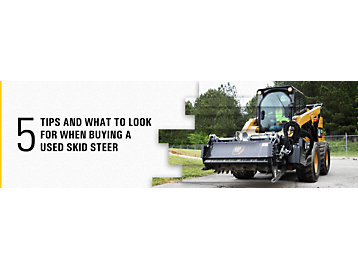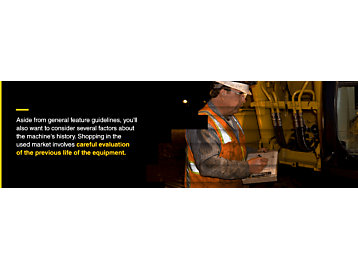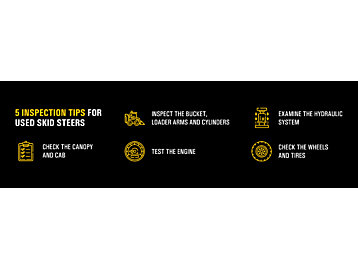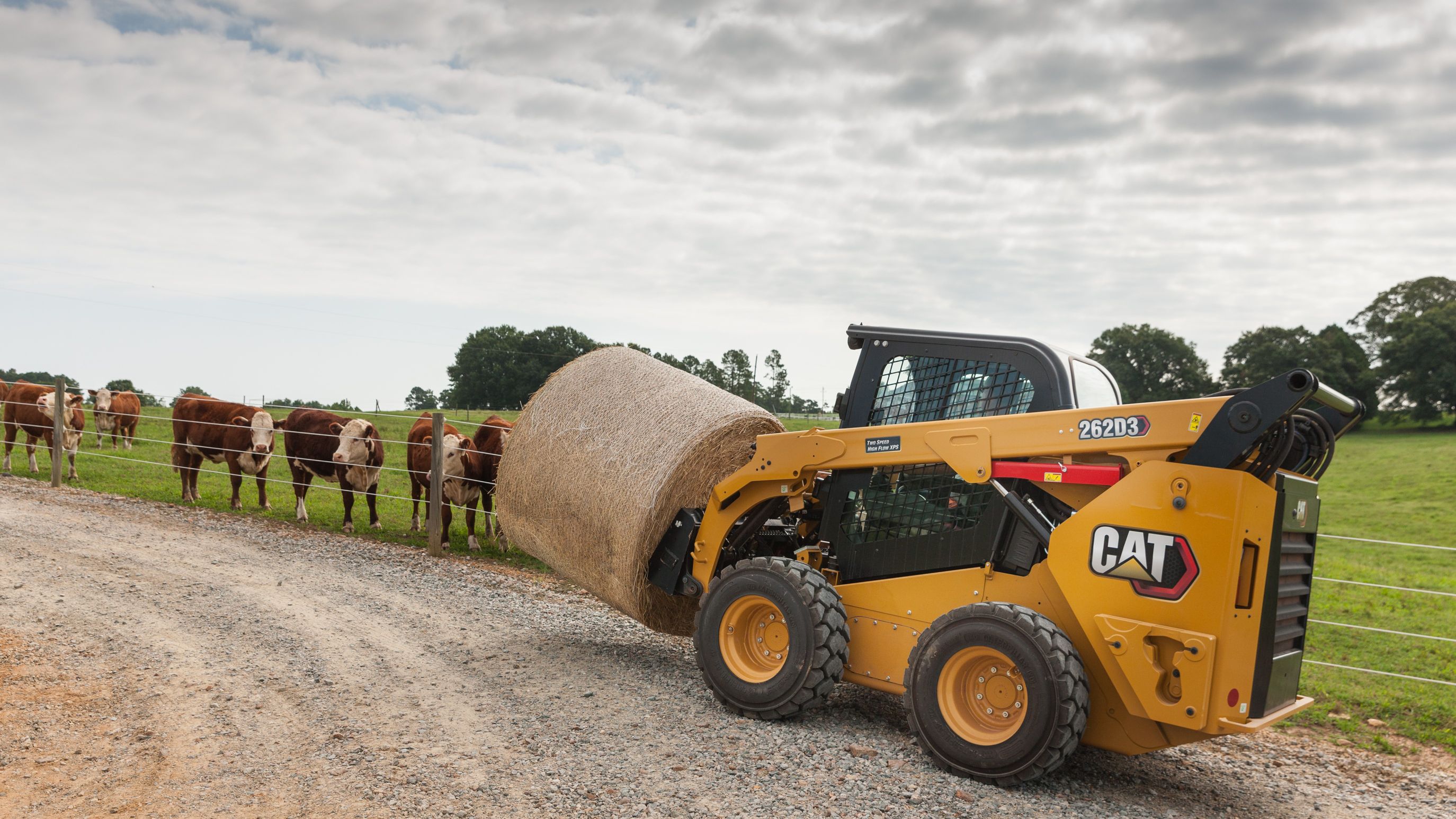If you already have an existing account with another Cat App, you can use the same account to sign in here.
One Account. All of Cat.
Your Caterpillar account is the single account you use to log in to select services and applications we offer. Shop for parts and machines online, manage your fleet, go mobile, and more.
Account Information
Site Settings
Security
Author: Small Business Expert | September 18, 2020 | Topic: Used Equipment

If you're in the market for a skid steer, you've probably considered buying used. Used equipment is an excellent way to get more value out of your purchase and reduce the risk associated with a heavy machinery investment. But buying used has a few more considerations than buying new, as you'll have to factor in the equipment's history, condition and seller alongside the typical decisions you have to make with a new purchase. Consider this your used skid steer buying guide, where you can pick up some used skid steer inspection tips and learn what to look for when buying a used skid steer.
Benefits of Buying a Used Skid Steer
There are unique advantages to buying a used skid steer for your next project. Some of the benefits of buying a used skid steer loader include:
- A better purchase price: The most obvious benefit is the reduction in cost. Used machinery is typically more affordable than new vehicles. No matter what industry you're in, extra cash can help you get more work done and accomplish a wide variety of goals.
- Less depreciation: There's a common adage that a new car loses around 10%-20% of its value when you drive it off the lot. The same principle applies to new machinery, and managing depreciation isn't for everyone. A new piece of machinery will depreciate faster at first than an old one, so you can save significantly by buying a skid steer that's already seen its steepest years of depreciation.
- Less risk: Since there is less depreciation in a used machine, it may be more palatable to companies that want as little risk as possible.
- Peace of mind: With less risk associated with your purchase, you can rest easy — especially if your equipment comes from a reputable brand known for longevity, like Caterpillar.
What to Consider When Buying a Used Skid Steer
There are many factors to think about when you decide to buy a skid steer. Some are influenced by the type of work you do, while others will depend on your financial situation. Here are some things to look for when buying a used skid steer:
- Size and power: Some skid steers work well in more compact environments, while others have more power for tough jobs. Do you need something with that extra power, or will a smaller size help you maintain maneuverability? Trying to use the wrong size of equipment can hurt productivity. Still, size and power are not always directly related — sometimes you can get more power out of a smaller machine. Either way, you'll still need to identify what you're looking for.
- Hydraulics: Skid steers typically come with a standard hydraulic package that matches the machine, but if you have more intensive applications, an additional high-flow hydraulic package may be worthwhile. You'll also want to ensure that the machine's auxiliary hydraulic flow and rated operating capacity can match those of the attachments you want to use.
- Attachments: Part of the beauty of skid steers lies in their versatility. They can be snowplows, planers, buckets, stump grinders and so much more. If you know the attachments you want beforehand, you can ensure your skid steer is compatible. Also, look out for quick-attach tools that you may be able to use on more than one piece of equipment.
- Lift type: Radial and vertical lifts work best for certain tasks. Radial lift models are great for excavating and digging, while vertical lifts are good for materials handling and moving items at truck-bed level.
- Tires: There are three popular types of tires you may find on a used skid steer, including air-filled tires, foam-filled tires and solid rubber tires. Air-filled tires work well on rough exterior surfaces thanks to their large treads. But, they're more vulnerable to sharp objects that can damage them. Foam-filled tires are more costly, but can withstand sharp objects. They are heavier, though, and can wear on the transmission more. Solid rubber tires are thin but heavy, good for use indoors or on smooth pavement. They won't go flat.
- Dump height: If you plan to use a skid steer for loading applications or elevated platforms, you may need a specific height clearance.
- Manufacturer support: The manufacturer of your skid steer may determine how easy it is to get parts, tires and warranty service. Some manufacturers may be harder to source than others, adding significant downtime and costs to any needed repairs. Buying from a dealer associated with a manufacturer like Caterpillar allows for better access to genuine parts and lets you take advantage of longer warranties or certified used programs.
Take some time to identify what you'll need within each of these elements before you go skid steer shopping. It will help you narrow things down and find the right piece of equipment.
What to Look for in a Used Skid Steer's History
Aside from general feature guidelines, you'll also want to consider several factors about the machine's history. Shopping in the used market involves careful evaluation of the previous life of the equipment. Think about the following tips for buying a used skid steer loader before you shop:

- Type of work: The environment of a skid steer will play a large role in its wear and tear. A tool used for intermittent snowplowing or loading hay bales won't be nearly as worn as one used in heavy-duty, full-time construction work.
- Ownership: Consider how many owners the tool has had and what kind of owner they were. Fewer owners is generally better, but usage will play a more significant role in a piece of equipment's condition. Private and corporate sellers might treat vehicles differently. Private sellers may devote individual attention to a vehicle, but trustworthy businesses like rental fleet owners typically have robust maintenance procedures, so you know the machine was well cared for.
- Log hours: Log hours provide an idea of how often and how hard the machine was worked. A skid steer may be run part or full time. Full time typically refers to 5 hours-6 hours a day, while part-time machines only put in about 15 hours a week. In general, shoot for a skid steer with fewer hours on it. A newer vehicle with lots of hours has been pushed harder in a shorter amount of time than an older vehicle with fewer hours, meaning it has experienced more wear. Still, hours aren't as indicative of condition as care, but you should pay careful attention to high-hour machines.
- Maintenance practices: An exceptional owner will keep thorough records of maintenance events and prove how well they took care of the machine. Maintenance is a particularly reliable method of judging a skid steer's condition.
- Transportation costs: If buying a skid steer anywhere other than your place of operations, remember to factor in the costs of transportation. Customs and other logistics can quickly drive up the price of getting a used skid steer in your hands. Buy from a nearby dealer to avoid these costs.
The history of a skid steer will tell you a lot more about what kind of value it offers you. Condition is critical and understanding where it's been and how it's been maintained can help you evaluate accordingly.
5 Inspection Tips for Used Skid Steers
One of the most important parts of buying a used machine is the physical inspection. By spending time on this step, you can significantly cut back on the risks of purchasing the equipment. If you know your way around a skid steer, you can do these checks yourself, but it may be better to bring a trusted mechanic along with you.
Here are some of the things to check before buying a used skid steer.

1. Check the Canopy and Cab
Hop inside and check the cabin for proper safety features. The protective enclosure should be free of bends and damage to ensure driver safety in the event of a rollover. The windows should be properly enclosed. Make sure the steps and grab handles are sturdy and that the safety bar and seat belt work.
Next, take a look at various operational functions and give them a test, including the:
- Horn
- Backup alarm
- Breaks
- Lights
- Gauges
- Switches
- Rearview camera
- Coupler
- Controls
- Heater and AC
Some wear on non-critical components is expected and may not be a deal-breaker, but you should be aware of any flaws and ensure the price matches. Conduct an inspection on the skid steer's body, looking for scratches, scuffs, dents, fresh paint jobs or welds covering up damage. Again, some wear and tear is acceptable — these machines are in heavy-duty environments, after all — but should not be excessive.
2. Inspect the Bucket, Loader Arms and Cylinders
To check for wear on the bucket, look at its leading edge, the cutting teeth, side panels and bottom for signs of wear or damage. Check the cylinders for cracks or leaks and the loader arms for welds, which could be a sign of a repair.
3. Test the Engine
Pop open the rear engine to look for signs of leaks, wear or dirt buildup. You'll want to look at the oil level and condition, checking for excessive thickness. Look at belt tightness and condition, along with the air filter.
An additional signal of engine issues is a loud knocking or rattling on startup.
4. Examine the Hydraulic System
Closely inspect the hydraulic system for signs of leaks or excessive moisture. There should be some fluid around the auxiliary hydraulics, but not a large amount. Check the hoses for damage, too.
To test the bucket, lift it up and watch for any sinking or turning. If it stays in place, it should be good to go.
5. Check the Wheels and Tires
Keep in mind that new tires can be an expensive replacement on a skid steer, and the equipment will need them eventually. Recently replaced tires may be more valuable since they'll last you longer. Regardless of age, check the tires for appropriate inflation, tight lug nuts, leaks, damage or uneven wear.
Why Buy a Used Skid Steer From Cat Used?
Buying a used skid steer from a trustworthy brand can provide a lot of confidence and peace of mind. At Cat Used, we have a strong selection of used skid steers with all the value, quality and durability you expect from Cat® machinery.
When you buy Caterpillar, you get:
- Strong life cycle value: Cat machines are fuel-efficient and built to last, which means you may end up spending less money on maintenance needs and fuel than you would for a skid steer from another manufacturer.
- Higher resale value: Part of the appeal of buying used is minimizing depreciation and having the flexibility to resell your equipment when you're done with it. Cat equipment holds its value well, so you can be sure you're getting as much out of your investment as possible.
- Detailed service records: Many Cat Used machines come with lots of service records, so you can be confident in your skid steer's maintenance history.
- Support: When you purchase a piece of equipment from Cat Used, you get like-new support. Just because you're spending less on a machine doesn't mean you should get any less assistance.
- Confidence: The Caterpillar name inspires reliability and trust. Seasoned industry experts know they can turn to Caterpillar when they need a high-quality machine perfect for the task at hand.
- Financing options: With Cat Used, you can still find flexible financing options for a variety of situations.
- The Cat Certified Used program: Cat dealers offer a wide array of used equipment, but some products meet more rigorous inspection standards. These products get certified with a Cat seal of approval. A Cat Certified Used skid steer is often one that is lightly used, though it may be gently serviced to get it to a good-as-new condition. Many dealers also provide a strict inspection report and tack on an Equipment Protection Plan.
Find a Cat® Dealer Today
Now that you know what to consider when buying a used skid steer, you can better prepare for the purchase process. Whether you're looking for durability, dependency, maneuverability or something else, your Cat dealer can help you find the perfect machine.
You'll get top-notch service and a great selection of used skid steers carried at dealers across the country. Don't forget about Cat Certified Used products that give you like-new equipment with full inspection reports and a strong Cat warranty. If the choices seem vast, don't worry, our dealers can help you navigate them.
Contact your local Cat dealer today to learn more about buying a used skid steer loader.







